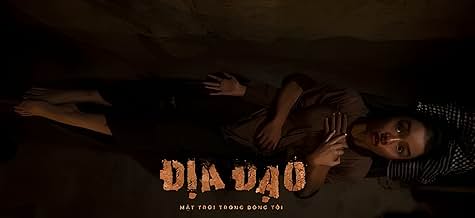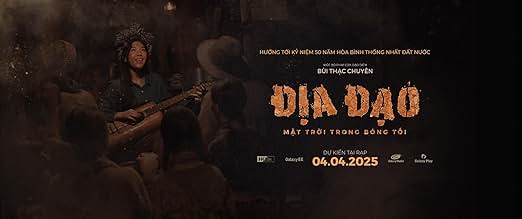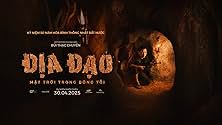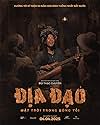Aggiungi una trama nella tua linguaIn 1967, as the Vietnam War raged, a Vietnamese revolutionary guerrilla team became the U.S. military's top target - charged with safeguarding a secret group of intelligence agents at all co... Leggi tuttoIn 1967, as the Vietnam War raged, a Vietnamese revolutionary guerrilla team became the U.S. military's top target - charged with safeguarding a secret group of intelligence agents at all costs.In 1967, as the Vietnam War raged, a Vietnamese revolutionary guerrilla team became the U.S. military's top target - charged with safeguarding a secret group of intelligence agents at all costs.
- Regia
- Sceneggiatura
- Star
Recensioni in evidenza
Vietnamese cinema has long explored the theme of war, but few films have approached it with the scale, precision, and emotional resonance of The Tunnels: Sun in the Shadows. Directed by Bui Thac Chuyen, this film not only reconstructs a brutal chapter of Vietnamese history but also boldly asserts that Vietnam is capable of producing war films with both artistic integrity and cinematic ambition.
When the setting becomes the protagonist
Inspired by the Cu Chi tunnel system during the Vietnam War, the film takes place in 1967-one of the war's most intense years. However, the true protagonist here is not a person, but the tunnels themselves: a claustrophobic, living ecosystem beneath the ground. Through tight, shadow-filled cinematography and minimal lighting, the audience does not simply observe life underground-they inhabit it, feeling the heat, the tension, and the ever-present fear.
There are no long expositions or forced monologues. Instead, the film tells its story through images and silence: sweaty faces, rushed meals, and hushed conversations drowned out by planes overhead. The director trusts the audience to understand fear and resilience through breath, glances, and stillness.
Deliberate pacing with emotional weight
The first half of the film unfolds slowly, immersing viewers in the daily rhythms of tunnel life. Some may find the pacing subdued, but it is a deliberate choice-to portray the quiet persistence and fragile humanity of soldiers living beneath the soil. When the enemy's incursion begins, the tempo shifts, yet the film avoids turning into an action spectacle. Even the combat scenes are crafted with clarity and restraint, maintaining emotional resonance over spectacle.
Complex characters with moral ambiguity
Beyond the tunnels, three central characters anchor the narrative: Commander Bay Theo (played by Thai Hoa), engineer Tu Dap (Quang Tuan), and fighter Ba Huong (Thu Anh). Each represents a different facet of wartime survival: Bay Theo is gruff yet introspective, Tu Dap is intelligent but emotionally volatile, and Ba Huong is both courageous and vulnerable.
Crucially, the film does not idealize its characters. They make mistakes, carry flaws, and experience moments of fear. But it is precisely their imperfections that make their courage meaningful. Their humanity emerges not from their heroism but from their internal conflict.
Minor flaws, major impact
Despite its strengths, the film has a few shortcomings. The tunnel structure may be disorienting for some viewers unfamiliar with the setting. Some secondary characters feel underdeveloped, and the second act occasionally loses focus due to uneven pacing and editing. Nevertheless, the emotional payoff of the final act is strong enough to outweigh these limitations.
Conclusion
The Tunnels: Sun in the Shadows is a bold and thoughtful entry in the landscape of Vietnamese war cinema. It avoids patriotic excess and sentimentality, choosing instead to portray war through an intimate, human lens. With restrained dialogue, immersive visuals, and emotional subtlety, the film demonstrates that Vietnam does not need to imitate Hollywood to create powerful cinema.
If Vietnamese cinema is to reach the global stage on its own terms, The Tunnels is strong evidence that it already has the tools, stories, and vision to do so.
When the setting becomes the protagonist
Inspired by the Cu Chi tunnel system during the Vietnam War, the film takes place in 1967-one of the war's most intense years. However, the true protagonist here is not a person, but the tunnels themselves: a claustrophobic, living ecosystem beneath the ground. Through tight, shadow-filled cinematography and minimal lighting, the audience does not simply observe life underground-they inhabit it, feeling the heat, the tension, and the ever-present fear.
There are no long expositions or forced monologues. Instead, the film tells its story through images and silence: sweaty faces, rushed meals, and hushed conversations drowned out by planes overhead. The director trusts the audience to understand fear and resilience through breath, glances, and stillness.
Deliberate pacing with emotional weight
The first half of the film unfolds slowly, immersing viewers in the daily rhythms of tunnel life. Some may find the pacing subdued, but it is a deliberate choice-to portray the quiet persistence and fragile humanity of soldiers living beneath the soil. When the enemy's incursion begins, the tempo shifts, yet the film avoids turning into an action spectacle. Even the combat scenes are crafted with clarity and restraint, maintaining emotional resonance over spectacle.
Complex characters with moral ambiguity
Beyond the tunnels, three central characters anchor the narrative: Commander Bay Theo (played by Thai Hoa), engineer Tu Dap (Quang Tuan), and fighter Ba Huong (Thu Anh). Each represents a different facet of wartime survival: Bay Theo is gruff yet introspective, Tu Dap is intelligent but emotionally volatile, and Ba Huong is both courageous and vulnerable.
Crucially, the film does not idealize its characters. They make mistakes, carry flaws, and experience moments of fear. But it is precisely their imperfections that make their courage meaningful. Their humanity emerges not from their heroism but from their internal conflict.
Minor flaws, major impact
Despite its strengths, the film has a few shortcomings. The tunnel structure may be disorienting for some viewers unfamiliar with the setting. Some secondary characters feel underdeveloped, and the second act occasionally loses focus due to uneven pacing and editing. Nevertheless, the emotional payoff of the final act is strong enough to outweigh these limitations.
Conclusion
The Tunnels: Sun in the Shadows is a bold and thoughtful entry in the landscape of Vietnamese war cinema. It avoids patriotic excess and sentimentality, choosing instead to portray war through an intimate, human lens. With restrained dialogue, immersive visuals, and emotional subtlety, the film demonstrates that Vietnam does not need to imitate Hollywood to create powerful cinema.
If Vietnamese cinema is to reach the global stage on its own terms, The Tunnels is strong evidence that it already has the tools, stories, and vision to do so.
The concept is terrific-a war movie crafted with a setting and perspective that, at times, evoke the atmosphere of a horror film.
To bring this vision to life, Bui Thac Chuyen shows remarkable restraint, opting for a minimalist yet impactful approach-from the acting and sparse dialogue to the subtle use of patriotic symbolism. It's rare to see a Vietnamese director place such trust in the audience's ability to interpret and feel.
Unfortunately, the editing undermines much of that intention. Some scenes are difficult to follow, while others verge on unintentionally comedic due to awkward cut timing. Most frustrating of all, the dialogue is often hard to hear. As a native Vietnamese speaker, I found it absurd that I had to rely on English subtitles just to understand what the characters were saying.
That said, it's still refreshing to see a Vietnamese film with a clear, confident identity-one that doesn't depend on rapid-fire dialogues and petty arguments to move the plot forward.
To bring this vision to life, Bui Thac Chuyen shows remarkable restraint, opting for a minimalist yet impactful approach-from the acting and sparse dialogue to the subtle use of patriotic symbolism. It's rare to see a Vietnamese director place such trust in the audience's ability to interpret and feel.
Unfortunately, the editing undermines much of that intention. Some scenes are difficult to follow, while others verge on unintentionally comedic due to awkward cut timing. Most frustrating of all, the dialogue is often hard to hear. As a native Vietnamese speaker, I found it absurd that I had to rely on English subtitles just to understand what the characters were saying.
That said, it's still refreshing to see a Vietnamese film with a clear, confident identity-one that doesn't depend on rapid-fire dialogues and petty arguments to move the plot forward.
I'm a Vietnamese born in peacetime-even my parents' generation didn't really witness the full consequences of our long resistance wars. I only knew about the wars against the French and the Americans through school lessons and bits of information on social media.
But 'Tunnel' really hit me. It completely shifted my perspective on war. The film powerfully depicts the toughness and resilience of the people in the Cu Chi tunnels in particular, and the Vietnamese people of that time in general; as well a. The 250 kilometers of dark, suffocating tunnels beneath the ground were where they lived, planned, and prepared to fight back against American forces with tanks and advanced weapons. That's how we've come to have the peaceful life we live today, and I'm deeply grateful for that.
The use of period-specific language was a nice touch. There's one intimate scene in the film that was very tastefully done and felt true to the character's humanity. And it doesn't over-glorify the Vietnamese side, nor does it vilify the Americans-U. S. soldiers are portrayed as tough and skilled fighters.
The color grading in the film is beautiful. I'm not entirely sure how others might view this film-I studied at an art school and have some understanding of cinema, but with any film, different people will connect with it in different ways. Personally, I found it deeply impressive-both in terms of the director's craft and the stories told in and around the film.
But 'Tunnel' really hit me. It completely shifted my perspective on war. The film powerfully depicts the toughness and resilience of the people in the Cu Chi tunnels in particular, and the Vietnamese people of that time in general; as well a. The 250 kilometers of dark, suffocating tunnels beneath the ground were where they lived, planned, and prepared to fight back against American forces with tanks and advanced weapons. That's how we've come to have the peaceful life we live today, and I'm deeply grateful for that.
The use of period-specific language was a nice touch. There's one intimate scene in the film that was very tastefully done and felt true to the character's humanity. And it doesn't over-glorify the Vietnamese side, nor does it vilify the Americans-U. S. soldiers are portrayed as tough and skilled fighters.
The color grading in the film is beautiful. I'm not entirely sure how others might view this film-I studied at an art school and have some understanding of cinema, but with any film, different people will connect with it in different ways. Personally, I found it deeply impressive-both in terms of the director's craft and the stories told in and around the film.
I held my breath watching the film. To me, it was deeply moving. I trembled at times as I watched it. Anyone who has been to Cu Chi has likely heard stories about the terror of both the guerrilla fighters and the sweeping raids. But seeing it all brought to life in the film filled me with both fear and admiration. The story and the way it was told were very different from typical state-produced films - deeply human, incredibly raw, and full of real life. The characters and details were developed with consultation from real heroes of the past war. Although I was on the verge of tears many times while watching the film, Dia Dao is certainly not a tearjerker. Instead, it lets us experience the restrained emotions of the soldiers, who had to suppress their feelings because danger was always present - there was no room for soft emotions to take over. At the same time, the personal stories, the bonds, and the genuine affection among humble people truly help us believe in and better understand the many reasons behind the victories of Cu Chi in particular, and Vietnam as a whole.
Tunnel 2025 is an emotional and realistic portrayal of the struggles and sacrifices made during a pivotal time in Vietnam's history. The film does a great job capturing the raw emotions and the human side of war, making it more than just a historical retelling-it's a story that touches the heart.
While some scenes were a bit difficult to follow, especially for viewers unfamiliar with certain historical contexts, the overall message remains powerful. The film serves as a reminder of the determination and unity that helped shape our nation.
Vietnamese youngsters should definitely watch Tunnel 2025. It's not just a film-it's an opportunity to better understand the sacrifices our ancestors made and the lengths they went to in order to reunite our country.
While some scenes were a bit difficult to follow, especially for viewers unfamiliar with certain historical contexts, the overall message remains powerful. The film serves as a reminder of the determination and unity that helped shape our nation.
Vietnamese youngsters should definitely watch Tunnel 2025. It's not just a film-it's an opportunity to better understand the sacrifices our ancestors made and the lengths they went to in order to reunite our country.
Lo sapevi?
- Versioni alternativeAn alternate version, titled the Director's Cut, was released on April 30, 2025. This cut is 3 minutes shorter than the original theatrical version.
I più visti
Accedi per valutare e creare un elenco di titoli salvati per ottenere consigli personalizzati
Dettagli
- Data di uscita
- Paese di origine
- Lingua
- Celebre anche come
- Địa Đạo: Mặt Trời Trong Bóng Tối
- Luoghi delle riprese
- Aziende produttrici
- Vedi altri crediti dell’azienda su IMDbPro
Botteghino
- Budget
- 2.240.000 USD (previsto)
- Lordo in tutto il mondo
- 6.641.870 USD
- Tempo di esecuzione2 ore 8 minuti
- Colore
- Mix di suoni
- Proporzioni
- 2.76 : 1
Contribuisci a questa pagina
Suggerisci una modifica o aggiungi i contenuti mancanti


















